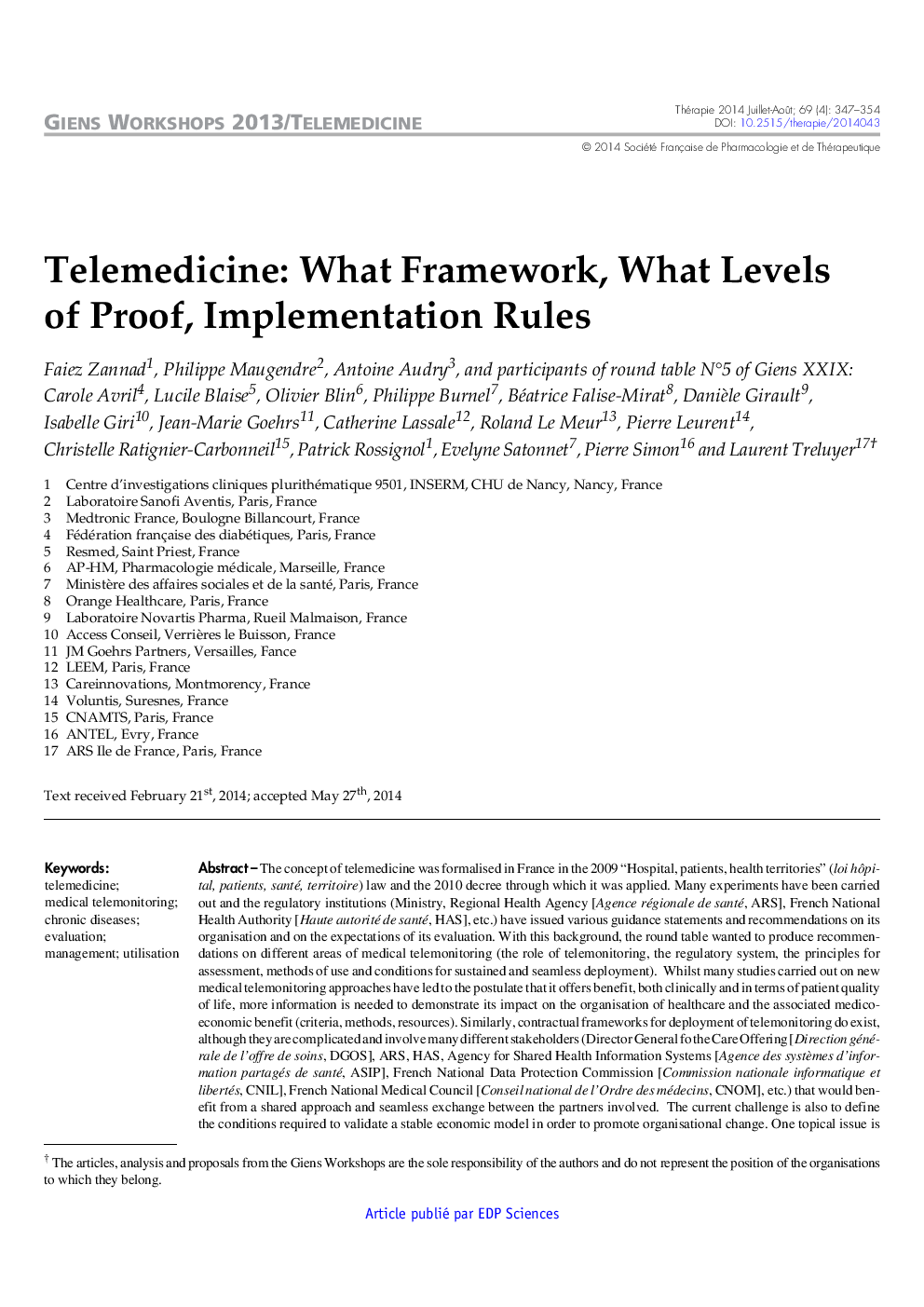| کد مقاله | کد نشریه | سال انتشار | مقاله انگلیسی | نسخه تمام متن |
|---|---|---|---|---|
| 2578832 | 1130016 | 2014 | 8 صفحه PDF | دانلود رایگان |
عنوان انگلیسی مقاله ISI
Telemedicine: What Framework, What Levels of Proof, Implementation Rules
دانلود مقاله + سفارش ترجمه
دانلود مقاله ISI انگلیسی
رایگان برای ایرانیان
کلمات کلیدی
ASIPCNOMCCTIRSLFSSDGOSCNAMTSPHRCRound TableCEPSEHPADCNILSNIIRAMCSISANSMHTAHASARSDSSHPSTCPPevaluation - ارزیابیhealth technology assessment - ارزیابی فناوری سلامتUtilisation - استفادهChronic diseases - بیماری های مزمنTelemedicine - تله مدیسینMedical device - دستگاه پزشکیCSF - مایع مغزی نخاعیManagement - مدیریتmast - مشت
موضوعات مرتبط
علوم پزشکی و سلامت
داروسازی، سم شناسی و علوم دارویی
فارماکولوژی، سم شناسی و اقلام دارویی (عمومی)
پیش نمایش صفحه اول مقاله

چکیده انگلیسی
The concept of telemedicine was formalised in France in the 2009 “Hospital, patients, health territories” (loi hôpital, patients, santé, territoire) law and the 2010 decree through which it was applied. Many experiments have been carried out and the regulatory institutions (Ministry, Regional Health Agency [Agence régionale de santé, ARS], French National Health Authority [Haute autorité de santé, HAS], etc.) have issued various guidance statements and recommendations on its organisation and on the expectations of its evaluation. With this background, the round table wanted to produce recommendations on different areas of medical telemonitoring (the role of telemonitoring, the regulatory system, the principles for assessment, methods of use and conditions for sustained and seamless deployment). Whilst many studies carried out on new medical telemonitoring approaches have led to the postulate that it offers benefit, both clinically and in terms of patient quality of life, more information is needed to demonstrate its impact on the organisation of healthcare and the associated medicoeconomic benefit (criteria, methods, resources). Similarly, contractual frameworks for deployment of telemonitoring do exist, although they are complicated and involve many different stakeholders (Director General fo the Care Offering [Direction générale de l'offre de soins, DGOS], ARS, HAS, Agency for Shared Health Information Systems [Agence des systèmes d'information partagés de santé, ASIP], French National Data Protection Commission [Commission nationale informatique et libertés, CNIL], French National Medical Council [Conseil national de l'Ordre des médecins, CNOM], etc.) that would benefit from a shared approach and seamless exchange between the partners involved. The current challenge is also to define the conditions required to validate a stable economic model in order to promote organisational change. One topical issue is placing the emphasis on its evaluation and operation. Access to patient data, particularly data from the health insurance funds and the use of these data, may enable the process to be more effective. In addition, the budgetary non-fungibility of the various financial envelopes for the different areas of work, restricts the consolidation of financial impact. Funding methods will need to be adapted to this new distribution of roles, both at the centre of the healthcare system and in the industrial ecosystem. All of these changes will help the leaders of our healthcare system to bring this new ambition closer to all of the people working in the health economy.
ناشر
Database: Elsevier - ScienceDirect (ساینس دایرکت)
Journal: Thérapie - Volume 69, Issue 4, JulyâAugust 2014, Pages 347-354
Journal: Thérapie - Volume 69, Issue 4, JulyâAugust 2014, Pages 347-354
نویسندگان
Faiez Zannad, Philippe Maugendre, Antoine Audry, participants of round table N°5 of Giens XXIX: participants of round table N°5 of Giens XXIX:, Carole Avril, Lucile Blaise, Olivier Blin, Philippe Burnel, Béatrice Falise-Mirat, Danièle Girault,